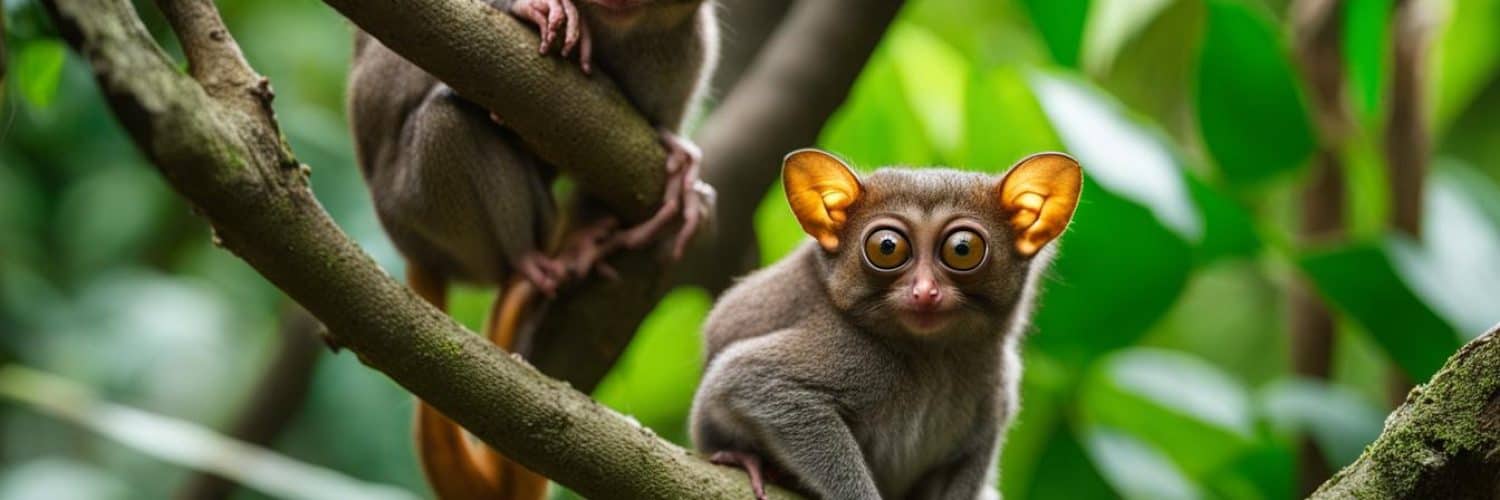Welcome to the enchanting Philippine Tarsier Sanctuary in Bohol, Philippines! Nestled in the heart of the island, this sanctuary is a haven for the critically endangered Philippine Tarsier and offers a unique eco-tourism experience. Immerse yourself in the beauty of nature as you discover these mesmerizing creatures in their natural habitat.
Spanning over 134 hectares of secondary forest, the sanctuary is a dedication to tarsier conservation. Here, you can witness these saucer-eyed primates up close, observe their fascinating behaviors and learn about their importance in the ecosystem. It’s an experience that not only educates but also instills a sense of responsibility towards protecting these remarkable creatures.
Key Takeaways:
- Explore the Philippine Tarsier Sanctuary in Bohol, a dedicated conservation area for the critically endangered Philippine Tarsier.
- Discover the unique characteristics of the tarsier species, such as their ability to leap long distances and rotate their heads almost 360 degrees.
- Support tarsier conservation efforts through sustainable tourism and donations to the Philippine Tarsier Foundation.
- Experience the rich biodiversity of Bohol by exploring the surrounding wildlife sanctuary, home to rare bird species, monkeys, and other fascinating wildlife.
- Plan your visit to the sanctuary, ensuring enough time to observe these incredible creatures and contribute to their conservation.
Discovering the Tarsiers in the Wild
In the Canapnapan barangay of Corella, visitors can explore the Philippine Tarsier Sanctuary and see these saucer-eyed primates in the wild. The sanctuary is home to over 100 tarsiers, with only eight in the designated viewing area. Experienced guides lead visitors through a short jungle trail to observe the tarsiers up close. It is important to note that flash photography is not permitted to avoid disturbing the tarsiers. The visitors center provides informative boards, and the sanctuary is well-managed, creating a pleasurable experience for visitors.
“Exploring the Philippine Tarsier Sanctuary was truly a remarkable experience. Walking through the picturesque jungle trail, we were greeted by the mesmerizing gaze of the tarsiers in their natural habitat. The knowledgeable guides shared fascinating insights about the tarsiers’ behavior and the importance of habitat preservation. It was truly a memorable wildlife encounter!” – Anna, enthusiastic visitor
| Key Highlights: |
|---|
| Glimpse into the wild tarsier habitat |
| Experienced guides for a close encounter |
| No flash photography for tarsier well-being |
| Informative visitor center |
The Fascinating World of the Tarsier
The tarsier is not only one of the world’s smallest primates but also the oldest surviving member of the primate group, with a history of 45 million years. These incredible creatures have unique characteristics that set them apart from other primates.
Unique Physical Traits
One of the most remarkable features of the tarsier is its ability to leap an impressive 5 meters, making it an agile and efficient hunter. Additionally, tarsiers have the extraordinary capability to rotate their heads almost 360 degrees, allowing them to detect prey and potential threats from all directions. They can also move their ears in the direction of sound, enhancing their ability to locate prey or communicate with other tarsiers.
However, what truly captures the attention of observers are the tarsier’s large eyes. Measuring 150 times larger than a human’s in relation to their body size, these large eyes give the tarsier its enchanting appearance and provide exceptional night vision for hunting in the darkness of the forest.
Endangered Species Conservation
“The tarsier is an endangered species.”
Despite their fascinating characteristics, tarsiers face numerous threats that have led to their endangered status. Habitat destruction due to deforestation, the introduction of invasive species, hunting, and the illegal pet trade are all factors contributing to their decline. Without immediate conservation efforts, these enchanting primates may face extinction.
| Threats to Tarsiers | Contributing Factors |
|---|---|
| Habitat Destruction | Deforestation, land conversion |
| Invasive Species | Compete for resources, prey on tarsiers |
| Hunting | Poaching for bushmeat, medicinal use |
| Pet Trade | Illegal capture and sale of tarsiers |
It is crucial to raise awareness about the conservation needs of tarsiers and take action to protect their natural habitat. Through education, advocacy, and sustainable tourism practices, we can contribute to the preservation of these remarkable creatures for future generations.
Supporting Tarsier Conservation Efforts
Bohol, known for its commitment to sustainable tourism, is actively promoting tarsier awareness and taking significant steps towards the preservation of these endangered primates. By visiting the Philippine Tarsier Sanctuary and actively participating in sustainable tourism practices, visitors can play a pivotal role in supporting the ongoing conservation efforts and ensuring the survival of the tarsier species.
The Philippine Tarsier Sanctuary sets a remarkable example with its well-managed environment and strict guidelines to protect the tarsiers and their fragile habitat. Visitors are encouraged to maintain a respectful distance, refrain from making loud noises, and avoid flash photography to minimize any disturbance to these delicate creatures.
“Preserving the tarsiers and their habitat is not just a responsibility, but also a testament to our commitment to nature and wildlife conservation in the region,” says Dr. Maria Santos, a prominent wildlife expert in Bohol.
Through their visit to the sanctuary, tourists not only have an incredible opportunity to witness the fascinating world of the tarsiers but also contribute to raising awareness about the importance of protecting these unique creatures and preserving their natural habitat.
Sustainable Tourism Guidelines
| Guidelines | Benefits |
|---|---|
| Maintain a respectful distance from tarsiers | Promotes their natural behavior and minimizes stress |
| Avoid loud noises | Prevents disruption of their environment and nesting behavior |
| Avoid flash photography | Prevents potential harm to their sensitive eyes |
| Observe designated trails and pathways | Preserves the natural habitat and prevents damage |
| Support conservation efforts through donations | Contributes to research, habitat preservation, and educational programs |
By embracing sustainable tourism and following these guidelines, visitors can make a meaningful impact in the conservation of the tarsiers and the preservation of the surrounding wildlife sanctuary. Together, we can ensure the ongoing survival and protection of these enchanting creatures for future generations to appreciate and cherish.
Exploring the Surrounding Wildlife Sanctuary
Visitors to the Philippine Tarsier Sanctuary can also embark on longer guided walks in the picturesque surrounding wildlife sanctuary. While the enchanting tarsiers are predominantly found in the immediate vicinity of the visitors center, avid hikers will have the opportunity to venture into the lush forested areas, where they may spot tarsiers beyond the designated viewing zones.
Immersing oneself in the captivating beauty of the wildlife sanctuary offers a unique chance to connect with nature and witness the rich biodiversity of Bohol. The sanctuary serves as a sanctuary not just for tarsiers, but also for a diverse array of other fascinating wildlife species. Keep your eyes peeled for the presence of rare bird species, playful monkeys, graceful monitor lizards, elusive pythons, majestic cobras, and even nocturnal civet cats.
Embark on a Hiking Adventure
If you’re up for an adventurous experience, hiking in the wildlife sanctuary is a must-do activity. Lace up your hiking boots and follow the well-marked trails that wind through the sanctuary’s pristine habitats. Feel the thrill of the unknown as you navigate the lush foliage, listening to the sounds of nature and discovering hidden treasures along the way.
As you walk deeper into the sanctuary, the chance to spot tarsiers in their natural habitat becomes more exhilarating. Keep your camera ready and your senses alert, as these elusive creatures may grace you with their presence as you continue your exploration.
Longer Guided Walks
For those who desire a more in-depth encounter with the wilderness, the sanctuary offers longer guided walks led by experienced local guides. These knowledgeable guides will share insights about the sanctuary’s flora and fauna, as well as provide fascinating anecdotes about the tarsiers and their conservation.
The longer guided walks allow visitors to delve further into the heart of the sanctuary, immersing themselves in the unmatched beauty of the natural surroundings. Whether you’re a nature enthusiast, a wildlife lover, or simply seeking a peaceful retreat from the hustle and bustle of everyday life, these longer guided walks are the perfect opportunity to connect with the wonders of the wildlife sanctuary.
Experience the serenity of the wildlife sanctuary as you hike through its stunning landscape, soak in the sights and sounds of nature, and potentially encounter tarsiers in their natural habitat. It’s an adventure that will leave you with cherished memories and a renewed appreciation for the incredible diversity of life.
Embarking on a hiking expedition in the wildlife sanctuary offers the chance to witness the natural wonders of Bohol up close. The image above captures the breathtaking beauty of the sanctuary, enticing you to embark on your own hiking adventure and explore the wonders that await.
Getting to the Philippine Tarsier Sanctuary
Are you planning a visit to the Philippines and looking for unique tourist attractions in Bohol? The Philippine Tarsier Sanctuary is a must-visit destination for nature enthusiasts and wildlife lovers. Located just a short distance from Tagbilaran City, getting to the sanctuary is convenient and straightforward.
To reach the Philippine Tarsier Sanctuary from Tagbilaran City, you can take a Sikatuna-bound jeepney. The fare is approximately P25, and the journey takes around 45 minutes. The jeepney ride itself is an experience, allowing you to soak in the stunning views of Bohol as you make your way to the sanctuary.
If you are in Loboc, you can also catch a jeepney heading to Tagbilaran that passes by the Philippine Tarsier Sanctuary. This option costs about P25 and takes approximately 40 minutes, offering you an opportunity to explore different parts of the beautiful Bohol countryside.
No advance booking is required for visiting the sanctuary. Upon arrival, visitors can simply walk in and pay the entrance fee of P60 per person during the opening hours from 8:30 am to 4:00 pm. It’s that easy!
Ideal Time to Visit the Sanctuary
When planning a visit to the Philippine Tarsier Sanctuary, the best time to go depends on your itinerary. If you are part of a package tour or including the sanctuary in a Bohol Countryside tour, it is advisable to visit in the morning. This is because the sanctuary closes at 4:00 pm, and starting early ensures you have enough time to explore the sanctuary and observe the tarsiers.
However, if the Philippine Tarsier Sanctuary is the main attraction or one of the few destinations on your itinerary, it is recommended to visit in the afternoon between 1:00 pm and 3:00 pm. This allows you to have a leisurely morning and arrive at the sanctuary during the optimal time for tarsier viewing.
Did you know?
The Philippine Tarsier Sanctuary is a popular stop on the Bohol Countryside tour, which takes visitors to some of the most scenic and culturally significant spots on the island. Make the most of your visit by planning the ideal time to see the tarsiers.
Whether you choose the morning or afternoon for your visit, experiencing the Philippine Tarsier Sanctuary is a truly unique and memorable encounter with these fascinating creatures. Plan your visit accordingly and make the most of your time at this incredible sanctuary.
Supporting Tarsier Conservation
After experiencing the wonders of the Philippine Tarsier Sanctuary, visitors may feel inspired to contribute to the ongoing conservation efforts for these unique primates. By making donations to the Philippine Tarsier Foundation, individuals can help ensure the protection and preservation of the tarsier species and their natural habitat.
Donations can be made easily through the sanctuary’s website. Simply visit https://www.philippinetarsierfoundation.org/donate to make a contribution. Every donation, no matter how small, plays a crucial role in supporting the foundation’s vital work.
In addition to monetary donations, visitors can also support tarsier conservation efforts by spreading awareness through social media. Follow the Philippine Tarsier Foundation on Facebook, Twitter, and Instagram to stay updated on their latest initiatives and share their posts to raise awareness among friends and family.
For any inquiries or further information, visitors can contact the Philippine Tarsier Foundation via email at in**@*************************on.org. The foundation’s team is always ready to answer questions and provide more ways through which individuals can contribute to tarsier conservation.
Conclusion
The Philippine Tarsier Sanctuary in Bohol offers a unique experience for visitors to explore the world of these fascinating tiny primates and contribute to their conservation. By observing the tarsiers in their natural habitat, visitors not only have a memorable encounter but also gain a deeper understanding of the importance of tarsier conservation. The sanctuary’s well-managed trails and knowledgeable guides ensure a safe and informative journey through the tarsiers’ habitat.
Through eco-tourism in Bohol, visitors can actively support the preservation of tarsiers and their natural habitat. By spreading awareness and sharing their experiences, individuals can contribute to the ongoing efforts in tarsier conservation. Additionally, visitors can make donations to the Philippine Tarsier Foundation, which plays a vital role in protecting and conserving these endangered species.
Exploring the Philippine Tarsier Sanctuary offers a truly unique eco-tourism experience in Bohol. It not only provides an opportunity to witness these enchanting creatures up close but also promotes the importance of conserving our natural heritage. By engaging in responsible tourism practices and supporting tarsier conservation efforts, we can ensure that future generations will have the chance to appreciate these remarkable animals and the remarkable ecosystem they call home.
FAQ
Can I see tarsiers in their natural habitat at the Philippine Tarsier Sanctuary?
Yes, the Philippine Tarsier Sanctuary offers visitors the opportunity to observe tarsiers in their natural habitat.
How many tarsiers can I see at the sanctuary?
The sanctuary is home to over 100 tarsiers, with only eight in the designated viewing area.
Is flash photography allowed at the Philippine Tarsier Sanctuary?
No, flash photography is not permitted to avoid disturbing the tarsiers.
What other wildlife can I encounter at the sanctuary?
Aside from tarsiers, the sanctuary is a haven for diverse wildlife, including rare bird species, monkeys, monitor lizards, pythons, cobras, and civet cats.
How do I get to the Philippine Tarsier Sanctuary?
Visitors can take a Sikatuna-bound jeepney from Tagbilaran City or a jeepney from Loboc to Tagbilaran that passes by the sanctuary. The travel time is approximately 45 minutes from Tagbilaran and 40 minutes from Loboc.
What are the opening hours of the sanctuary?
The sanctuary is open from 8:30 am to 4:00 pm.
When is the best time to visit the Philippine Tarsier Sanctuary?
If visiting as part of a package tour or including it in a Bohol Countryside tour, it is advisable to visit in the morning. However, if the sanctuary is the main attraction, it is recommended to visit in the afternoon between 1:00 pm and 3:00 pm.
How can I support tarsier conservation efforts?
What is the importance of tarsier conservation?
Tarsier conservation is crucial for preserving the species and their natural habitat for future generations. It contributes to biodiversity and raises awareness about the importance of protecting endangered species.


















Add comment